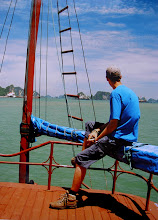The girls left the Baths after their afternoon cookout and headed over to Virgin Gorda Yacht Harbor to reprovision for the trip. After a quick stop into the local market the girls planned out the meals for the remainder of the trip. Leaving VGYH, we headed upwind to North Sound, Virgin Gorda. The girls came into the channel marking Colquhoun reef at sunset and anchored as the light faded in the lee of Prickly Pear Island. The girls grilled fish for fish tacos and prepared for a big day in North Sound tomorrow.
Saturday, July 28, 2012
Baths, Virgin Gorda to Prickly Pear Island, North Sound via VGYH
RMS Rhone to the Baths
After leaving the RMS Rhone, the girls set sail for the Baths on Virgin Gorda. On the upwind sail we worked on sail trim and the girls worked on speeding up their rigging, furling, and tacking. Once we arrived at Virgin Gorda the girls picked up a mooring ball and swam to shore. We hiked to Devils Bay and snorkeled back to Spring Bay for an afternoon cookout at the Baths
The Girls in the Cave on the hike to Devil's Bay
The Girls on the Trail to Devil's Bay
The group getting together before the Snorkel to Spring Bay
Relaxing in Devils Bay
Underwater Pics in Devils Bay
Thumbs up after a great snorkel.
Depart Cooper Island Snorkel RMS Rhone
The girls woke up early and took advantage of the great sea conditions and headed over to Salt Island to Snorkel the RMS Rhone - The girls were able to snorkel the RMS Rhone guided by Captain Stuart and Captain Jim who guided the tour from below the waves on SCUBA. Here is a quick video from their dive.
The Royal Mail Steam ship Rhone was commissioned for the Royal Mail Packet Company in 1865 to carry mail and passengers from England to the Caribbean. More than 300 passenger cabins were included within her 310 foot length. Its design was unique, for it had both sail and steam power with one of the first steam-driven cast propellors. Captain Woolley, the Captain on the day, decided to anchor in Peter Island's Great Harbor due to an outbreak of yellow fever in St. Thomas.
On the morning of October 29th, 1867 he awoke to barometers falling fast and dark black clouds over Tortola. As it was October and hurricane season was thought to be over, he assumed it was just an early winter storm. Captain Woolley told the crew to fire up the boilers just in case and when the storm hit he needed full ahead even at anchor to hold position. The fearful roar of the hurricane blew howling winds from the North Northwest. A lull came - or as we know it today "the eye of the hurricane". Captain Wolley tried to make a break for open water away from the rocks and land. He headed out between Peter and Salt Islands. Most people onboard couldn't swim so crew were ordered to tie in all the passengers (sealing their fate). The second part of the hurricane hit with black skies and huge seas. Captain Wolley like all good English Captains had a cup of tea with a dash of rum, stirring it with his silver spoon as he navigated his ship through the channel past Salt Island. The rain was blinding so he tried to get a better look outside when a big wave washed him overboard off the bridge. He was never to be seen again.
Rhone was slowly pushed toward the rocks and finally hit Black Rock Point. The cold water hit the hot boiler causing a big explosion splitting the Rhone in half. The stern sank in 35' while the bow drifted slightly deeper into 80'. The vessel now rests in two main sections off Salt Island, near Black Rock.
Today the Rhone is considered to be one of the world's best wreck dives.
The Girls Snorkeling at the RMS Rhone
Great Visibility on the RMS Rhone this morning
Subscribe to:
Comments (Atom)















